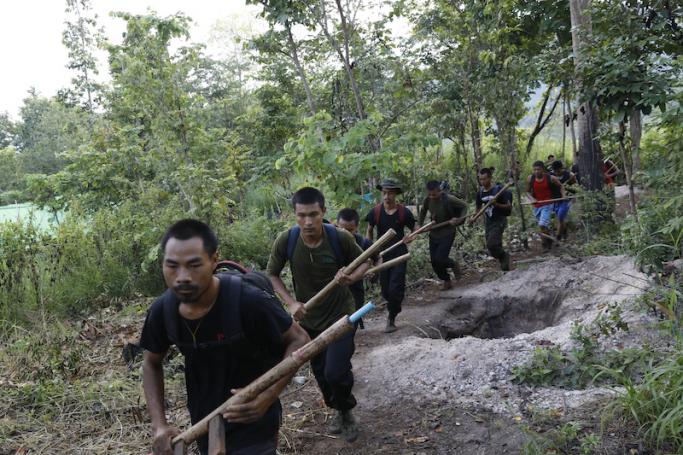Generation Z is in the forefront of the Spring Revolution resistance to oust the Myanmar military from power after it executed a coup in February 2021.
For many young people there is no other option than to fight.
This sentiment was reinforced in July following the junta announcement that the judiciary had hung four pro-democracy activists, an action that sent shockwaves through Myanmar and around the world.
The executions prompted outroar, with many youth reiterating their commitment.
One banner carried by Myanmar protesters in Tokyo recently summed up the sentiment – “Let us be the last generation under dictatorship”.
A large number of Generation Z activists have taken on board that it is crucial that they fight to get rid of military rule in Myanmar after the decades of misrule by the generals, beginning with General Ne Win who grabbed power in 1962.
Generation Z say they owe a debt of gratitude to the 8888 Movement activists who got the ball rolling in their protests in 1988 – an anniversary recently marked in the country.
Veterans of the 8888 democracy uprising are crucial players – including several in the National Unity Government (NUG) line-up. Their drive saw elections in 1990 – won in a landslide by Aung San Suu Kyi’s National League for Democracy (NLD) – only to see their efforts quashed when the military nullified the results.
Surviving members of the 8888 Movement may provide inspiration. But now the ball is in the young people’s court. Most of those on the front-line of the battles against the Myanmar security forces today are in their late teens to 20s and mid-30s.
There is irony in this demographic being the spearhead for change in Myanmar, according to analysts. In many ways they were spoilt growing up over the last decade as the country opened up, and the smartphone became ubiquitous. Gen Z are tech-savvy and connected through social media, not only to each other but also to the outside world and the possibilities for Myanmar if it were allowed to take its rightful place in the world community.
The ascension of Aung San Suu Kyi over the last decade, including the 2015 election victory for the NLD, provided hope to these young people, even though the military retained a sizeable grip on government, courtesy of the military-written 2008 Constitution.
But the flickering candle of hope was dashed on 1 February 2021 with the military coup. As experts like Dr Miemie Wynn Byrd explain, this is not the late 1980s or early 1990s when protestors were only able to take their resistance against the generals so far, before backing down, with some fleeing abroad – in an era when there was no internet in the country and communications were rudimentary.
Byrd, a Myanmar specialist at the Daniel K. Inouye Asia-Pacific Center for Security Studies (DKI APCSS) in Hawaii USA, has carefully studied Myanmar’s Gen Z and notes that they feel they have no other option now than to stand and deliver.
It is clear that Myanmar’s resistance groups, whether the NUG, Civil Disobedience Movement (CDM)or the militant People’s Defence Forces (PDF), are not running away. The more brutally the Myanmar generals crack down – including carrying out executions - the more the resistance groups dig in their heels. And many of them are barely out of school.
Saw Kapi, writing for Just Security and the International Human Rights Clinic at Harvard Law School, notes that young people and their drive have moved the country beyond the conventional framework articulated by many in the generation before them. Gen Z has shown a willingness to seek solutions during this historic moment that not only resist the Myanmar’s military but articulate an inclusive political vision for the country.
This is important.
With this generation’s leadership, there has been an unprecedented level of political awareness inside the country on two fronts: why the different ethnic nationalities have been struggling for decades for a more democratic society in a federal political framework – accompanied simultaneously by the collective acceptance among the various political forces that Myanmar’s military is the chief barrier to peace and stability in the country. These developments represent a seismic shift in political views across society, Saw Kapi says.
But it is also noticeable that those who have joined the resistance now are more aware of what their ethnic brothers and sisters have had to put up with over the decades, including the rapes, killings and burning of villages in the ethnic hinterlands. This reality seldom impinged on Bamar youth awareness in the past.
Young people are willing to risk their lives for real freedom.
Photos and video footage of PDF fighters offer a glimpse into the ages of this demographic. And those who have stepped up to shoulder a rifle are not just young men. There is a sizeable percentage of women who have fled to the jungle for training and action on the frontlines.
After witnessing unthinkable brutality from military personnel, young people had no choice but to take action, reports researcher Jesua Lynn.
“I am not a politician and I do not know anything about politics. But I know what is right and what is justice. I cannot keep silent if the military is treating me as an enemy and ruining our future,” university student Kyaw Kyaw, 23, told the researcher.
Kyaw Kyaw represents to voice of Myanmar’s youth today. It is a generation locked and loaded to once and for all get rid of the brutal generals.












